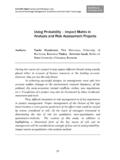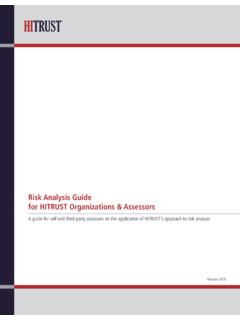Transcription of Value at Risk Analysis of a Bank's Balance Sheet
1 Value at Risk of a Bank's Balance Sheet by Thomas Ho President Global Advanced Technology Corporation Wall Street Plaza 88 Pine St. New York, NY 10005. (212) 785-9630. Allen A. Abrahamson Director of Research Global Advanced Technology Corporation (212) 785-9630. and Mark C. Abbott Senior Analyst Global Advanced Technology Corporation (212) 785-9630. December 1996. Through the application of a VaR Analysis to the Balance Sheet of a hypothetical bank this paper will address several issues important to bank managers.
2 We will establish which Balance Sheet accounts lend themselves to meaningful VaR measures and the kind of information needed for input to these measures. We explain how depositor and borrower behaviors are captured in the risk measures. We also address the accuracy of the measures, and how the bank can use the VaR. information for actionable decisions. The authors would like to thank Juha Reivonen, Postipankki Ltd., and Lars Soderlind, SE. Banken, for many of their suggestions and comments, and Fred Eng and Mitchell Talisman, of GAT, for their technical assistance.
3 D:\pdf\ 1. Value at Risk Analysis of a Bank's Balance Sheet A. Background Value -at-Risk (VaR) has been widely used for banks' trading portfolios and for risk management purposes. Using VaR, a bank can monitor the business risks that arise from a wide range of sources, including yield curve movements, liquidity of the market, and currency fluctuations. As a result, the bank can use VaR for line-of-business, regulatory compliance, budgeting, and many other corporate decisions. Recently, Katerina [1996] provided an overview of the applications of VaR to risk management of banks.
4 But VaR has not been widely applied to structural Balance sheets. Banks recognize that their risk has to be managed across the scope of their activities, that is, by integrating both the trading portfolio and the Bank's Balance Sheet . In principle, the trading portfolio is structured to implement hedging of the risks of the asset and liability categories found on the Balance Sheet . Therefore, it is an incomplete, if not erroneous, exercise to measure the risk of the trading portfolio in isolation to the structural Balance Sheet .
5 However, extending the VaR framework from securities in a portfolio to the Balance Sheet is not straightforward. Many technical and conceptual issues have to be resolved. The trading portfolio consists of positions that explicitly entail the cash flow characteristics of typical securities: specified principal amounts, known or forecasted cash flows, and defined maturities. Account balances of the Balance Sheet , on the other hand, are point in time snapshots of the dynamic process of lending and account gathering.
6 For example, a particular loan has a known term, and determinable cash flows. However, the Balance Sheet has non-determinant maturity customer accounts. VaR application to Balance Sheet accounts must address the following issues: What accounts on the Balance Sheet lend themselves to meaningful VaR measures? How is depositor and borrower behavior captured in the risk measures? Does the bank have all the information needed as input to VaR measures? Are the VaR measures accurate enough to be useful? How can the bank use the VaR information for actionable decisions?
7 This study addresses these questions through the advancement of a VaR Analysis applied to the Balance Sheet of a hypothetical bank . We will treat the stylized Balance Sheet shown in Figure 1. Our purpose is to describe the steps undertaken to derive the Value at Risk for the Bank's surplus, and then to discuss the managerial application of the VaR results. Figure 1. D:\pdf\ 2. Balance Sheet for bank , Aug. 31, 1996. (in millions). PRIME RATE LOANS 3,100. BASE RATE LOANS 2,100. VARIABLE RATE 600. FIXED RATE LOANS 1,200.
8 BONDS 3,000. =========. TOTAL ASSETS 10,000. BASE RATE TIME 2,000. PRIME RATE TIME 300. FIXED RATE TIME 500. DEMAND DEPOSITS 5,400. LONG TERM MARKET 1,200. =========. TOTAL LIABILITIES 9,400. SURPLUS 600. B. Methodology Value -at-Risk (VaR) methodology can contribute vital managerial information when it is integrated into the Bank's on-going risk management. As such, the VaR process is far more than the simple invocation of an encapsulated mathematical formula to measure risk. The VaR. method depends upon a process of information monitoring and Analysis .
9 An integral part of the VaR methodology is data Analysis and modeling of the individual items that will be subject to the VaR Analysis . Accordingly, we will first describe the preliminary requirements for data Analysis and modeling. These are the aspects of the process that require expert judgment and experience. This process has four parts, which involve economic modeling and expert experience and judgment in the modeling validation and evaluation. The process is also an integral part of on- going, day-to-day management procedures.
10 Indeed, GAT proposes a VaR methodology that is part of the Bank's risk management process. The four parts are: 1. Modeling the Structural Balance Sheet 2. Modeling the Risk Sources 3. Determining the Value at Risk (VaR) Measure 4. Establishing the Organization of risks D:\pdf\ 3. Each of these activities is described below. 1. Modeling the Structural Balance Sheet The Balance Sheet items are, of course, book values. Within each category, individual components have different maturities as well as different payment terms.




